
Antônio Carlos Gomes was the first New World composer whose work was accepted by Europe. He was the only non-European who was successful as an opera composer in Italy, during the "golden age of opera", contemporary to Verdi and Puccini and the first composer of non-European lineage to be accepted into the Classic tradition of music.
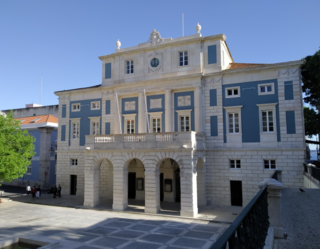
The Teatro Nacional de São Carlos is an opera house in Lisbon, Portugal. It was opened on June 30, 1793 by Queen Maria I as a replacement for the Tejo Opera House, which was destroyed in the 1755 Lisbon earthquake. The theatre is located in the historical center of Lisbon, in the Chiado district.

Duque de Caxias is a city on Guanabara Bay and part of Rio de Janeiro metropolitan area, being the 3rd most city populous in Rio de Janeiro state, southeastern Brazil.

The Pontifical Catholic University of Rio de Janeiro is a Jesuit, Catholic, pontifical university in Rio de Janeiro, Brazil. It is the joint responsibility of the Catholic Archdiocese of São Sebastião do Rio de Janeiro and the Society of Jesus. In 2019, PUC-Rio was ranked as the fourth best university in Latin America by Times Higher Education magazine.

Ronaldo Miranda is a Brazilian composer and music professor.

Itaqui is a municipality in Brazil, located in the southwestern part of the state of Rio Grande do Sul, close to the Argentinian border, between Uruguaiana and São Borja. It sits at a mean altitude of 57 meters (187 ft), by the Uruguay River. Its population is currently estimated at 37,489.

The Theatro Municipal is an opera house in the Centro district of Rio de Janeiro, Brazil. Built in the early twentieth century, it is considered to be one of the most beautiful and important theaters in the country.

The Paço Imperial, or Imperial Palace, previously known as the Royal Palace of Rio de Janeiro and Palace of the Viceroys, is a historic building in the center of the city of Rio de Janeiro, Brazil. The Paço Imperial was built in the 18th century to serve as a residence for the governors of colonial Brazil. From 1808, it was used as a royal residence by King John VI of Portugal as King of Portugal and later also as King of Brazil. In 1822 it became the city palace of the monarchs of the Empire of Brazil, Pedro I and Pedro II, who used it not as a residence, but as a workplace. It was one of the main political centers of Brazil for nearly 150 years, from 1743 to 1889.
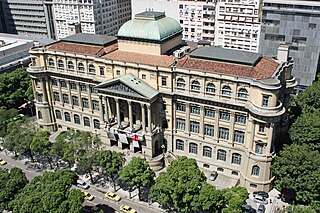
The Biblioteca Nacional do Brasil is the depository of the bibliographic and documentary heritage of Brazil. It is located in Rio de Janeiro, the capital city of Brazil from 1822 to 1960, more specifically at Cinelândia square.

Flamengo Park, also known as Aterro do Flamengo, Eduardo Gomes Park, and Aterro do Brigadeiro Eduardo Gomes, is the largest public park and recreation area within the city of Rio de Janeiro, in eastern Brazil.

Cinelândia is the popular name of a major public square in the centre of Rio de Janeiro, Brazil. Its official name is Praça Floriano Peixoto, in honour of the second president of Brazil, Floriano Peixoto.

Marcelo Mourão Gomes is a Brazilian ballet dancer who performed for two decades with the American Ballet Theatre.

The Theatro Lyrico Fluminense was one of the main theatres in Rio de Janeiro, Brazil, during the mid-19th century and was for many years the primary theatre for opera performances in that city. It was demolished on 30 April 1875 to make way for a park.

The Teatro Opera is a prominent cinema and theatre house in Buenos Aires, Argentina.

Silvio Sergio Bonaccorsi Barbato was an Italian-Brazilian opera conductor and composer. He died on board Air France Flight 447.
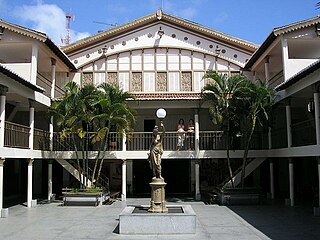
The Alberto Maranhão Theatre is a theatre located in the city of Natal, state of Rio Grande do Norte, Brazil.
"At the Teatro Alberto Maranhão, by its history, architectural beauty and tradition, the happiness of being here, walking in this place so full of artistic past."
Estúdios Globo, formerly known as Projac, is the main center of television production of the Grupo Globo and Latin Americas largest audio-visual production center. Opened in 1995, it is located in the city of Rio de Janeiro, Brazil. Often is called of CGP-Central Globo de Produção. The CGP-Central Globo de Produção, located between the neighborhoods of Curicica and Jacarepaguá, is the largest production center in the world, with an area of 1,600 km2 (620 sq mi), housing studios, fictional cities, islands of editing, post production, special effects, factory settings, costumes, technical support to production, administration and services. Currently, Projac holds thirteen recording studios, three snack bars, a restaurant, bank. They are often building new studios, centers support to fictional cities, a theater and an administrative building. In 2016, Projac was renamed to Estúdios Globo.

A Barraca is a Portuguese theatre company founded 1975 and directed by Hélder Costa and leading actress Maria do Céu Guerra. It is based at the Teatro Cinearte on 2 Largo de Santos, Lisbon.
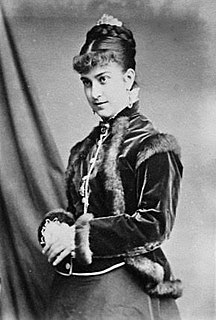
Lucinda Simões was one of the most acclaimed Portuguese actors and theatre directors in the late 19th and early 20th centuries. The former Teatro Lucinda in Rio de Janeiro was named after her.
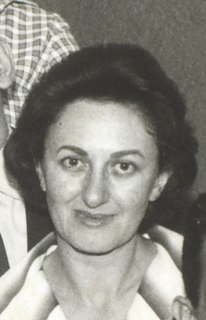
Ida Gomes, stage name of Ita Szafran was a Brazilian actress and voice actress born in Poland.


















